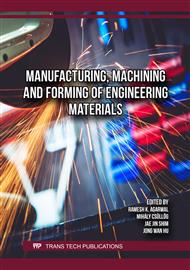[1]
G. Hussain, L. Gao, and N. U. Dar. An experimental study on some formability evaluation methods in negative incremental forming. Journal of Materials Processing Technology, 186(1- 3): 45–53, 2007.
DOI: 10.1016/j.jmatprotec.2006.12.005
Google Scholar
[2]
J. J. Park and Y. H. Kim. Fundamental studies on the incremental sheet metal forming technique. Journal of Materials Processing Technology, 140(1-3):447–453, 2003.
DOI: 10.1016/s0924-0136(03)00768-4
Google Scholar
[3]
I. Cerro, E. Maidagan, J. Arana, A. Rivero, et al. Theoretical and experimental analysis of the dieless incremental sheet forming process. Journal of Materials Processing Technology, 177(1- 3): 404–408, 2006.
DOI: 10.1016/j.jmatprotec.2006.04.078
Google Scholar
[4]
M. Habbachi and A. Baksa. Numerical modelling and experimental investigation of incremental sheet metal forming of aluminum alloy al 3003-o. In Journal of Physics: Conference Series, volume 2848, page 012006. IOP Publishing, 2024.
DOI: 10.1088/1742-6596/2848/1/012006
Google Scholar
[5]
M. Habbachi and A. Baksa. The effect of the drawing angle and the tool diameter on forming force prediction in single point incremental forming. In International Congress of Automotive and Transport Engineering, pages 341–353. Springer, 2024.
DOI: 10.1007/978-3-031-77631-1_29
Google Scholar
[6]
W. C. Emmens and A. H. van den Boogaard. An overview of stabilizing deformation mechanisms in incremental sheet forming. Journal of Materials Processing Technology, 209(8):3688–3695, 2009.
DOI: 10.1016/j.jmatprotec.2008.10.003
Google Scholar
[7]
Y. H. Kim and J. J. Park. Effect of process parameters on formability in incremental forming of sheet metal. Journal of materials processing technology, 130:42–46, 2002.
DOI: 10.1016/s0924-0136(02)00788-4
Google Scholar
[8]
K. Suresh, S. D. Bagade, and S. P. Regalla. Deformation behavior of extra deep drawing steel in single-point incremental forming. Materials and Manufacturing Processes, 30(10):1202–1209, 2015.
DOI: 10.1080/10426914.2014.994755
Google Scholar
[9]
M. Tisza, P. Z. Kovács, and Z. Lukács. Incremental forming: an innovative process for small batch production. In Materials Science Forum, volume 729, pages 85–90. Trans Tech Publ, 2013.
DOI: 10.4028/www.scientific.net/msf.729.85
Google Scholar
[10]
A. Zahedi Dizajyekan. Investigation of fracture mechanism in single point incremental forming of aa5052 aluminum alloy using the bao-wierzbicki damage model. Journal Of Applied and Computational Sciences in Mechanics, 35(4):63–76, 2023.
Google Scholar
[11]
G. Hussain, L. Gao, and N. Hayat. Improving profile accuracy in spif process through sta- tistical optimization of forming parameters. Journal of Mechanical Science and Technology, 25:177–182, 2011.
DOI: 10.1007/s12206-010-1018-8
Google Scholar
[12]
J. C. LI, L. I. Chong, and T. G. Zhou. Thickness distribution and mechanical property of sheet metal incremental forming based on numerical simulation. Transactions of Nonferrous Metals Society of China, 22:s54–s60, 2012.
DOI: 10.1016/s1003-6326(12)61683-5
Google Scholar
[13]
E. A. Abbas and K. K. Mansor. Numerical and experimental investigation of the effect of strength of aluminum 6061 alloy on thickness reduction in single-point incremental forming. Advances in Science and Technology. Research Journal, 17(4), 2023.
DOI: 10.12913/22998624/170713
Google Scholar
[14]
R. K. Mittal et al. Incremental sheet forming technologies: principles, merits, limitations, and applications. CRC Press, 2020.
DOI: 10.1201/9780429298905-2
Google Scholar
[15]
J. Jeswiet and D. Young. Forming limit diagrams for single-point incremental forming of alu- minium sheet. Proceedings of the Institution of Mechanical Engineers, Part B: Journal of Engi- neering Manufacture, 219(4):359–364, 2005.
DOI: 10.1243/095440505x32210
Google Scholar



